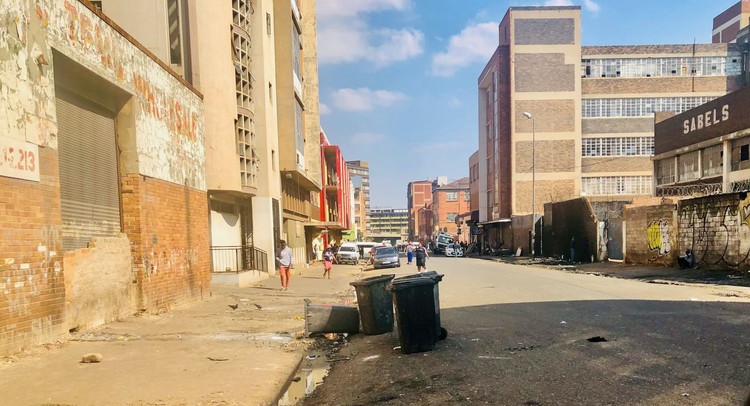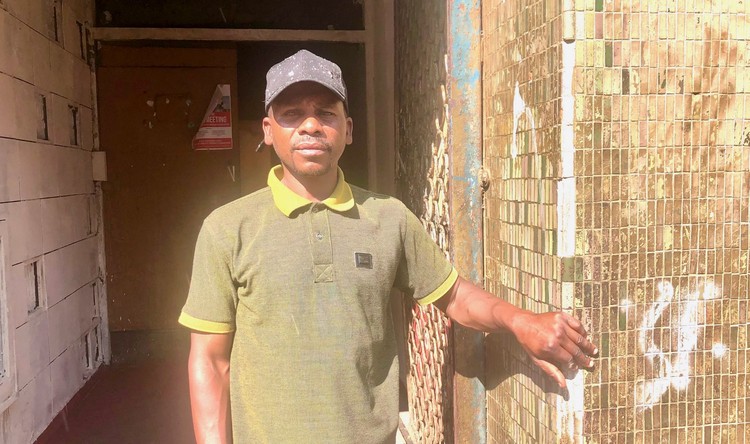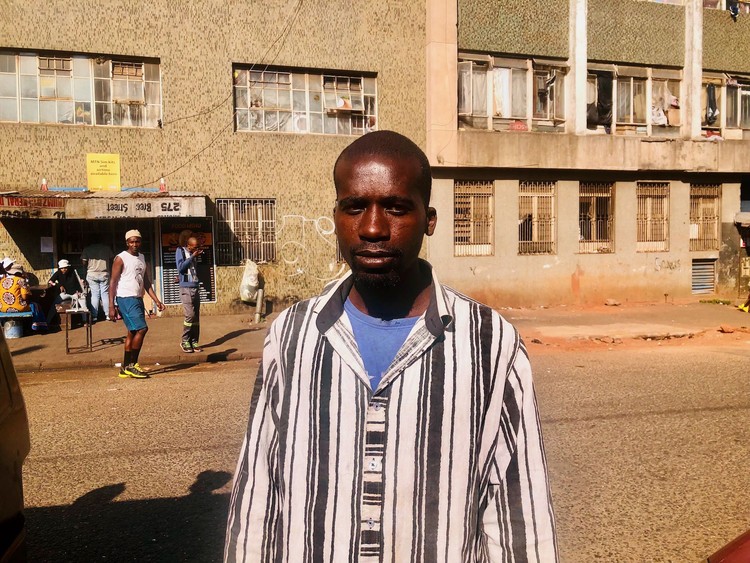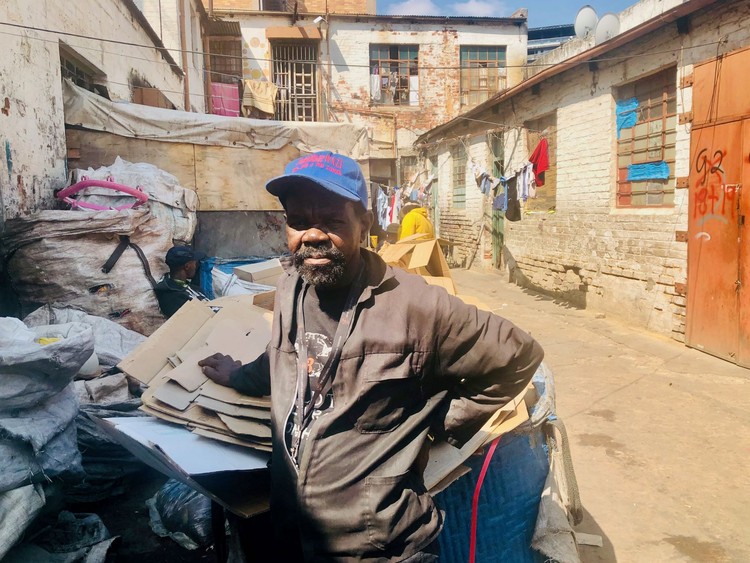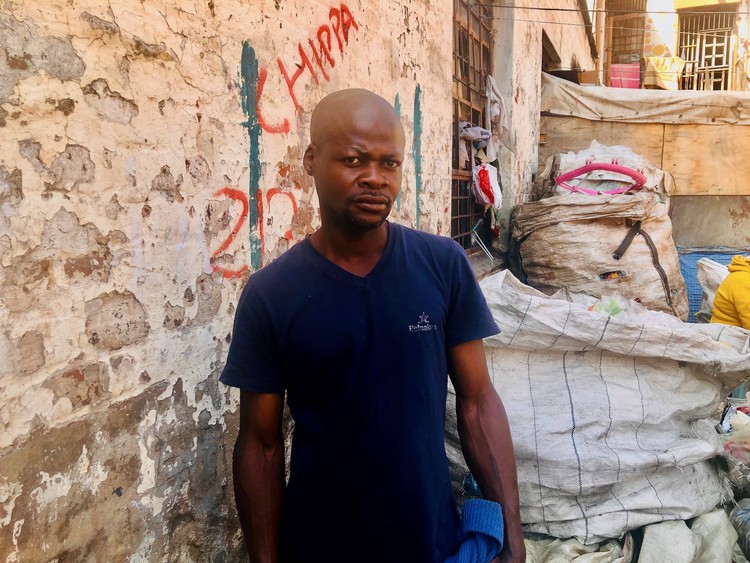Joburg City to blame for “dark buildings” crisis say property owners
Albert Street fire tragedy sparks renewed attempt to evict hundreds of people living in derelict downtown buildings
Over 200 households, some of whom have been living in buildings in Davies Street, Doornfontein for more than a decade, are facing a new round of eviction proceedings. Photos: Kimberly Mutandiro
- Owners of a number of “dark buildings” in downtown Johannesburg have been trying to evict hundreds of people occupying their properties for more than a decade.
- In the aftermath of the fire at 80 Albert Street that killed 77 people, the owners have now restarted eviction proceedings, saying another such disaster could be imminent.
- The Social Economic Rights Institute has been acting for the rights of the occupiers to prevent a situation in which about 600 people could find themselves out on the street.
- The owners of the buildings say the City has failed both them and the occupants and is largely to blame for the unresolved deadlock and deteriorating situation.
- The City denies this and says the owners have bungled their case.
In the aftermath of the 80 Albert Street inferno in which 77 people died, including 12 children, occupants of “dark buildings” in downtown Johannesburg say attempts to evict them have intensified.
About 200 households comprising more than 600 individuals, some of whom have been living in buildings in Davies Street, Doornfontein for 14 years, are facing fresh eviction proceedings.
The Social Economic Rights Institute (SERI) is opposing the eviction on the basis that the occupants have rights under the Prevention of Illegal Eviction from and Unlawful Occupation of Land Act (PIE Act).
SERI attorney Khululiwe Bengu said the court battle goes back to 2011 when White Wall Trading and Opal Wall Trading brought eviction applications against the occupants of buildings they own: numbers 32, 34, 36, 38, 39, and 40 Davies Street, and nearby 19 Sherwell Street.
After a lengthy process the eviction eventually failed, mainly because no suitable alternative accommodation was available for the occupants from the City of Johannesburg.
Then, after a fatal fire in 2017 in the Cape York building on the corner of Nugget and Rahima Moosa Street, there were renewed efforts to evict the Davies Street occupants and to relocate them to a single-storey building with two entrances, being 39 and 40 Davies Street.
At that time, the court ruled that the applicants had failed to prove that a fire in one building downtown was proof there would be fires in other buildings, Bhengu said. People could not be evicted on the basis of a future possibility.
Tragedy also struck on 19 April 2018 when a wall in the relocation building (39-40 Davies) collapsed, killing three children. The buildings’ owners furnish this as further proof that their buildings are dangerous and should not be occupied by anyone.
Following the 2017 fire, the City conducted raids on the Davies Street properties. These would later be ruled unlawful by the Constitutional Court in 2021, describing them as “cruel, degrading and invasive”.
GroundUp has also previously reported on the grim fate of City-relocated occupiers, including people evicted from the Cape York Building, who were left abandoned since 2017 at the City’s “temporary emergency” Wembley shelter.
In 2020, the owners approached the courts for case management after the matter stalled, partly because an assessment report required from the City had never been submitted despite numerous attempts to obtain it, according to the owners.
A High Court judge was appointed to see that each party complied with the previous court order. Case management meetings were held in which the City, for various reasons explained and unexplained, kept failing to fulfil its obligations, the owners say.
By October 2022 it was agreed the case management process had broken down and was unlikely to progress the matter. The owners withdrew, saying they had run out of funds after 12 years of litigation. The case went dormant.
After the Albert Street fire
Following the deadly Albert Street building fire, owners of the Davies Street buildings raised funds and again applied for an eviction order in September 2023 under a new case number.
Greg Vermaak of Vermaak Marshall Wellbeloved, representing White Wall Trading and Opal Wall Trading, said the case had been ongoing for over 12 years because the City was unable to provide emergency accommodation and the owner therefore cannot relocate the occupants.
“The buildings are the same as Albert Street. It’s a death trap,” said Vermaak.
“There are some buildings that are more dangerous to occupy than to be in the street. And this [Davies Buildings] is one of those.”
The owners argue that the conditions have been hazardous for over a decade and have only been deteriorating. They describe the property as “a powder keg” and repeatedly reference the Albert Road inferno in court papers.
The owners argue the circumstances meet the criteria of section 5 of the PIE Act that allows for eviction in a situation of imminent danger and where there is no other feasible remedy.
In court papers, the owners say the City has “proved unhelpful, if not recalcitrant” in attempts to resolve the state of the buildings. To the frustration of the owners, for years the City failed to share its assessment reports which would have seen the necessary steps taken to make the buildings safer against fire, as ordered by the court, they say.
It has also failed to act on its own “Problem Property” bylaws, regarding unsanitary and unsafe conditions. The City, the owners argue, has failed both the applicants and the respondents.
At one point during case management, SERI eventually went to the courts to compel the City to file its temporary relocation report. The City then failed to file a responding affidavit.
The owners argue that the City has acted with utter disregard for its constitutional obligations, and if the City is unable to fulfil these it should have called upon the Province to provide support.
“If the occupiers were to be evicted … without the provision of alternative accommodation from the City, they would be rendered homeless, as has been the case since 2011,” said Bhengu.
The City opposed the owners’ latest application. The matter was heard on 20 September. The case is awaiting judgment, said Bhengu.
SERI says the owners and the City can implement mitigation measures at the property that will improve the conditions pending the finalisation of the eviction application.
“Other avenues available to the owners include setting down the existing eviction case and compelling the City to provide a report and alternative accommodation to the occupiers,” SERI says.
City responds in court
At the time of publishing, the City had not replied to our questions. But in its heads of argument the City’s lawyers state: “The applicants seek to blame the City for the inappropriate bumbling of their own applications.” The City wants the owner’s new application to be struck down.
The City states the applicants, in citing the Albert Street fire, are using the same arguments they used after the York Street fire in 2017.
It states the owners, far from being concerned about the occupiers health and safety, want to “clear the way” for their development plans.
In balancing the harm suffered by the occupants, were they to be evicted, and that of the owners, were the occupants not evicted, the City argues: “The only hardship that the applicants could conceivably suffer is commercial. Moreover, that commercial hardship has prevailed since they owned the buildings and it is not new.”
The City lawyers state people have been occupying the buildings since 2001, and “conditions at the properties have not significantly deteriorated since the urgent proceedings brought in 2017”.
The City states “simple measures” can be taken, such as moving people to lower floors where necessary; maintaining and repair the premises; and installing fire extinguishers.
Furthermore the City states: “There is no indication in the founding affidavit that the supposed hijackers threaten the occupants in any way – on the contrary, the occupants claimed (in 2017 at least) to enjoy a peaceful existence and paying rental.”
The City’s lawyers also argue that bringing a new case under section 5 of the PIE Act is “sophistry” as it is inseparable from the 2011 case.
With regards to providing temporary emergency accommodation, the City argues that it has “not been established if the occupiers will be rendered homeless or how many could be rendered homeless”.
“Dire conditions”
The owners say the residents of their buildings live in “deplorable conditions” that are inhumane and undignified. In court papers, the owners suggest that the buildings are essentially vertical informal settlements with cardboard partitioned dwellings instead of shacks.
But the City says in its papers that two expert reports furnished by SERI – for the occupiers – suggest the conditions are not as bad as the owners make out, and the occupiers have detailed their efforts to clean, maintain and secure the properties at their own expense.
SERI counsel for the occupiers submits that: “The conditions in the building are not ideal but they protect the residents from the elements, safeguard them and their families from violent crime and are a secure place to keep their limited belongings.
“The residents have lived at the properties for years and have not experienced a fire or pest-driven disease outbreak at the properties or any of the other alleged hazards raised by the owners. They have access to water through shared communal taps and there is a refuse removal service at the properties.”
Water and electricity were cut off to Rosano Court, 32 Davies Street, years ago, but the occupants managed to reconnect the water and use illegal electricity connections.
When GroundUp visited, there were piles of refuse and a strong smell of sewage hung in the air. There has been no formal maintenance done to the buildings for more than a decade. There was also no sign of fire equipment.
Meet the residents
A “survey” by a task team from the social development department during City-led raids on five buildings conducted in 2017 found that contrary to popular belief, the occupants were mostly (60%) South Africans.
Lancy Moabi grew up at Rosano Court.
Lancy Moabi grew up at Rosano Court. He was a teenager when his mother, a domestic worker, moved into the building. He is now 40, has his own family, and has moved into another part of the building. Central Johannesburg is the only place he has ever lived. He survives on piecemeal jobs around the City.
“It would make no sense for the City to move us out of the inner city, because this is where we can survive. Even though I am unemployed, my family never goes hungry, because it’s easy to hustle in town,” he said.
Khulane Dube moved into Rosana Court five years ago.
When Khulane Dube moved into Rosana Court five years ago, he was told that they might be evicted at any time.
Dube survives on recycling and sometimes buying and selling merchandise on the streets. He says he has not managed to raise enough money to move to a better place. He hopes the City can provide alternative accommodation for himself and the other residents.
“It’s hard staying here … But we have no choice,” says Dube.
James Chiseko has built up a network with local business owners to sustain his livelihood selling recyclables.
“Being evicted from here would kill us. How else will we afford rent and send money home?” asks James Chiseko, another occupant of Rosana Court.
Chiseko has built up relationships over four years with various shop owners who exclusively supply him with their recyclables. The building, with its ideal location, allows him to securely store his materials. He makes about R2,000 a month and is able to send remittances to his family in Chitungwiza, Zimbabwe.
Petros Matimati has lived in 34 Davies Street for more than ten years.
Petros Matimati lives nearby at 34 Davies Street, his home for more than ten years. He shares a room with two other people and makes living by guarding and washing cars in the surrounding streets.
“The City has been here,” he said, “promising to get us places to live, but we have been waiting for years.”
Next: Khayelitsha animal clinic celebrates birthday with lively dog show
Previous: Catching waves: Surf school offers “safe haven” for boys in Muizenberg
© 2023 GroundUp. This article is licensed under a Creative Commons Attribution-NoDerivatives 4.0 International License.
You may republish this article, so long as you credit the authors and GroundUp, and do not change the text. Please include a link back to the original article.
We put an invisible pixel in the article so that we can count traffic to republishers. All analytics tools are solely on our servers. We do not give our logs to any third party. Logs are deleted after two weeks. We do not use any IP address identifying information except to count regional traffic. We are solely interested in counting hits, not tracking users. If you republish, please do not delete the invisible pixel.

